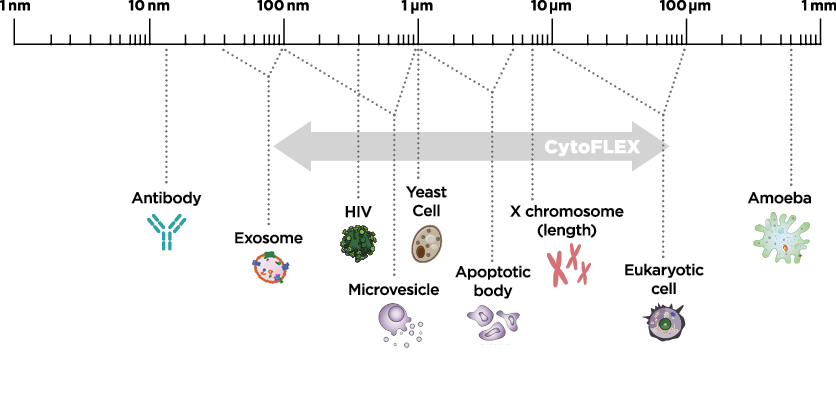Nanoparticle Detection

The advancement of flow cytometry into nanoparticle scale resolution, makes it possible to ask questions previously left to speculation. Several fundamental capabilities of flow cytometry make it an attractive platform for studying nanoparticles such as extracellular vesicles. That is the ability to detect large numbers of events, and discrimination of rare events, while simultaneously collecting information on phenotypic expression. The CytoFLEX Flow Cytometer has the resolution to detect 80 nm polystyrene particles. This facilitates analysis of biological nanoparticles within a phenotypic context.
The detection of sub-micron particles by flow cytometry becomes increasingly difficult as the particle sizes become smaller than the wavelength of the light being used to detect them. In addition, the amount of light scattered by any particle is directly proportional to the diameter of the particle and inversely proportional to the wavelength of the light being used to detect it. This relationship can be seen in the equations for both Mie Theory and Raleigh Light Scattering, which are used for calculating theoretical light scattering by particles either similar in size or much smaller than the wavelength of the light being used to detect them, respectively (Bohren & Huffmann, 2010).
 |
Moreover, upon entering a medium of a different refractive index, light waves are refracted by the new medium inversely proportional to the wavelength of the light, with smaller wavelengths having a higher refraction than larger wavelengths. This effect was first discovered by Isaac Newton when he split white light into a rainbow of individual colors using a prism, with red light refracting the least and violet light refracting the most (refer to graphic) (Newton, 1704). |
The CytoFLEX Platform of flow cytometers features the capability to measure side scatter off of the violet as well as the blue laser. This increases the range of particles that can be detected and analyzed within the sample. The smaller violet (405 nm) wavelength will result in more orthogonal light scattering at any given particle size than the blue (488 nm) wavelength, and will increase the range of resolution to smaller particles than can be detected by standard side scatter.
The use of violet light will help to amplify the differences in the refractive indices between the particles and their surrounding media, and in turn increases the ability to detect particles with a lower refractive index, such as exosomes, microvesicles and silica nanoparticles.

